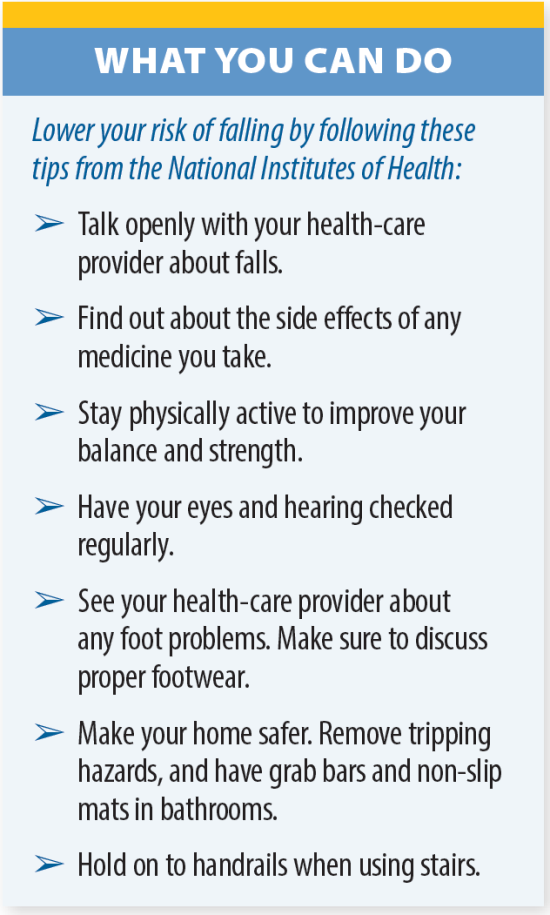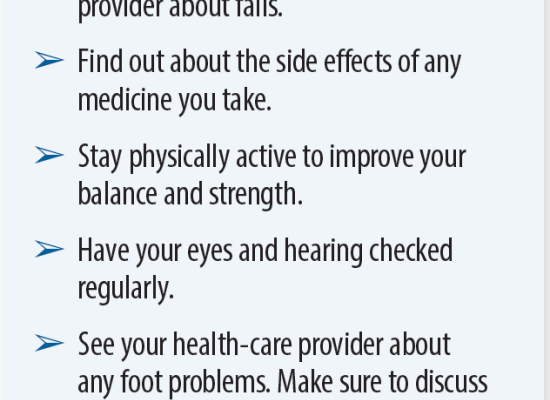Are You at Risk for a Fall?
Each year, about one in three adults ages 65 and older falls, and up to 30 percent suffer significant injuries, such as broken hips or head trauma, according to the Centers for Disease Control and Prevention. After a fall, some people may never be able to return to their former way of life. This sad outcome is potentially preventable with a fall-reduction plan.
A MultiPronged Approach
Awareness of what makes a person vulnerable to falls is an essential part of reducing personal risk. A fall-risk reduction plan thereforeshould include an assessment of the home, medications, and physical activity. For example, it’s important to get rid of tripping hazards, such as loose electrical cords, strewn pet or children’s toys, unsecured area rugs, and piles of newspapers that block common walking pathways. A home also needs to be well-lit, with accessible light switches at the top and bottom of staircases and long hallways. To allow for illuminated visits to the bathroom, nightlights are a must and should be either motion-activated or remain on throughout the night (such as with a simple, inexpensive timer).
Some medications may cause dizziness, and a person needs to be upfront and discuss this symptom with his or her physician. In many cases, the physician can adjust or replace the medication, or perhaps alter the dosage or the time of day when the medication is taken. But if this is not openly talked about, the risk remains in place.
Finally, there’s exercise. Some people love it. Some people don’t. And whether you like exercise or not, doing it most days of the week will reduce your fall risk and enrich your life in many ways.
“Studies have shown that exercise that includes aerobics, strengthening, flexibility and balance training three times a week can reduce a person’s fall risk,” says physical therapist Susan Stich, UCLA Department of Rehabilitation Services. “Other benefits of regular exercise include better rest, improved mood, decreased depression, and reduced pain.
Exercise need not be expensive or complicated. You can do it at home, and just 30 minutes a day can make a difference. Building the exercise habit isn’t always easy, but once the habit is formed, you may be surprised how much you look forward to that time to yourself. You may even feel dissatisfied if you miss a session because in a relatively short period of time most people realize how much better it feels to be regularly active.
According to recent research, engaging in regular physical activity has significant immediate and long-term benefits. A single session of moderate-to-vigorous exercise can reduce blood pressure, improve sleep, ease anxiety symptoms, and help regulate insulin sensitivity. Just days to weeks after adopting a new physical activity routine, you can decrease risk of certain cancers, reduce dementia risk, mitigate weight gain, improve overall physical functioning and lower fall risk.

Muscles Are Marvelous
While you may not be able to build the bulky muscles of a young Arnold Schwarzenegger, the now 74-year-old doesn’t quite look the same either. Nonetheless, he is incredibly vigorous and can out-bench-press men decades younger. However, not even a 13-time world champion body builder can rest on past successes. He has to hit the gym regularly, lift the weight, and do cardiovascular exercises—just like everyone else. Well, anyone that wants to stay fit and feel their best. His routine is reported to be a daily one. He goes to the gym around 7 a.m. for a 45-minute workout, rides his bike, and may do a second workout later in the evening. His fridge is filled with healthy, whole foods (e.g., veggies, eggs, almond milk). And while he enjoys a good steak every now and then, he mostly stays away from red meat.
While you certainly need nutritious food for good health, you don’t have to have a gym membership to get fit and stay fit. Muscles simply respond to exercise. They don’t know the difference between a fancy kettlebell or water-filled jug; they just love the load. Another exciting and hopefully motivating fact is that muscles can and do build at any age.
“Obviously, some medical conditions can affect muscles, such as neurological conditions,” says Stich, “But muscles can recover from disuse and begin to get strong again with regular and consistent use.”
That means virtually everyone at any age can benefit from exercise. As Schwarzenegger has said, biceps can’t be bought. Everyone has to earn them.
“It’s really never too late,” adds Stich. “Many people used to believe that as we age, muscles could no longer change and get stronger. That’s just not true. Studies show that muscles can get stronger into the 9th and 10th decades of life.”
Maintaining Independence
Maybe you’re not interested in doing what it takes to have a body builder’s physique in your 70s, but how about effortlessly getting out of a chair, rising from bed with minimal to no aches, or walking the beach at sunset with a beloved dog or special someone? Stich emphasizes that stronger muscles, especially around the hips and core, can make a big difference in maintaining an independent in life. See sample exercises below.
To reduce fall risk, an exercise routine should include muscle-strengthening (resistance training), balance, and cardiovascular activity. There are many forms of exercise that have that trifecta built into their routines. These include rigorous forms of yoga, Pilates, and dance fitness (e.g., Zumba with toning sticks). You can also create your own routines. For example, go for a brisk 30-minute walk with light hand weights, and then cool down with stretches and some focused core and balance work.
Finally, set a reachable goal, be it workout frequency (number of days per week), duration (workout length), and accomplishments (e.g., number of seconds balancing on one leg). Charting this journey can be rewarding and motivating. It can be as simple as logging the duration of a workout on a calendar placed on your refrigerator.
For more ideas on developing a customized exercise plan, consult with a personal trainer, physical therapist, or go to the National Institute on Aging website at tiny.cc/NIAExercise.

The post Are You at Risk for a Fall? appeared first on University Health News.


